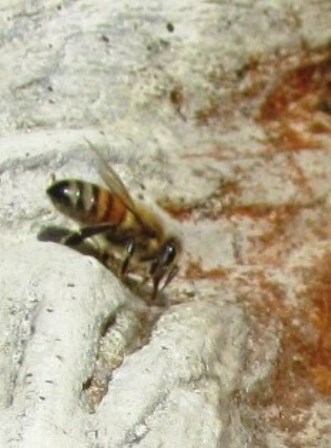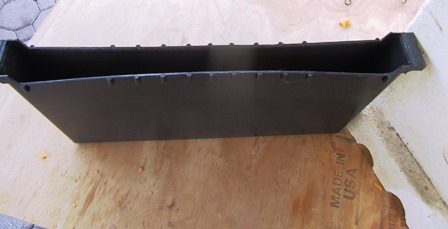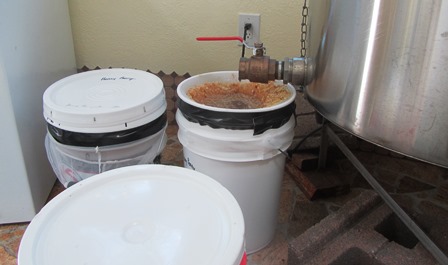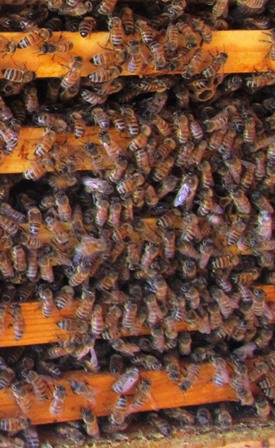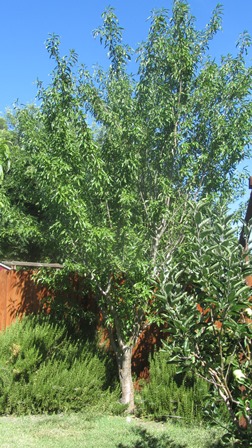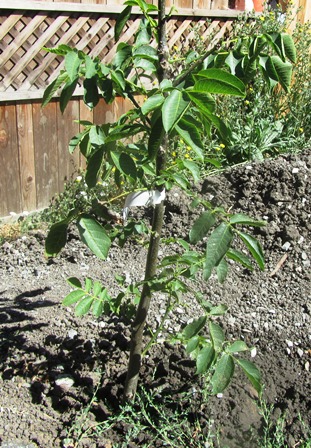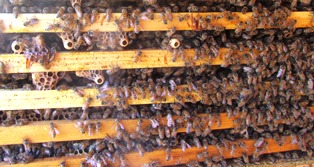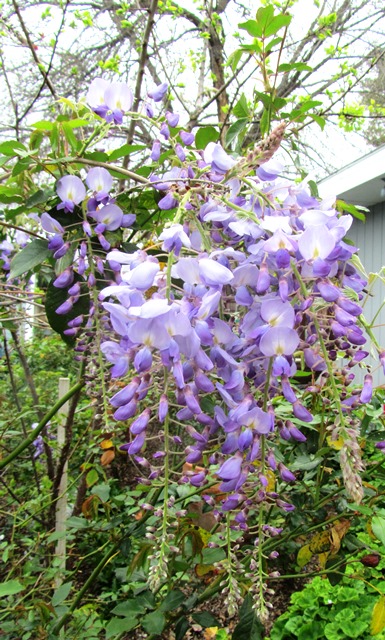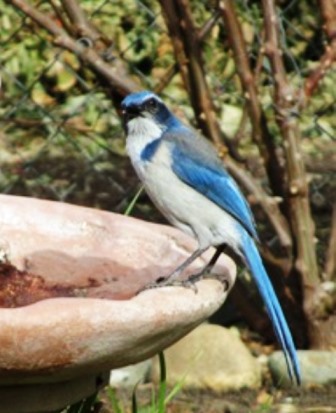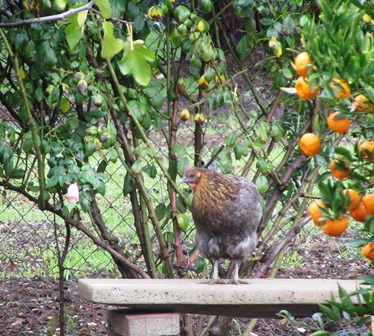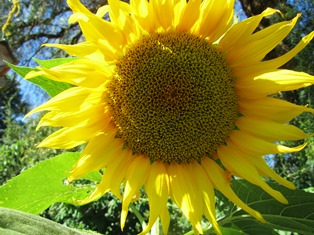Blog Archives
To Feed or Not to Feed the Bees?
Mid-September is a time when beekeepers check their hives and consider the prudence of harvesting more honey or leaving it as well as whether or not to feed the bees. Honeybees, like many living creatures on our planet, need food and water to survive.
My wise beekeeper neighbor tells me that the hive needs to have sixty pounds of honey to make it through winter. He’s feeding his bees now a mixture of sugar and water.
The sugar-water inserts are black plastic holders that get inserted right into the hive in place of a frame. They are rigid enough to hold the sugar-water but pliant enough to swell outward, so conventional wooden frames of honey and wax help them stay in place. The downside is that bees can drown in these feeders. And if the beekeeper lets them go empty, the enterprising bees will just build comb and honey inside them.
There are several kinds of feeders–all with benefits and also drawbacks. For more information on feeders, see: http://www.honeybeesuite.com/what-type-of-honey-bee-feeder-is-best/
Last year, I didn’t take honey in the fall. I wanted to ensure the bees had what they needed to survive after they’d been through yet another summer of drought. There aren’t a lot of pollen-rich flowers to be found now. However, star-thistle still dots dry hillsides of Contra Costa County (where I live) and particular eucalyptus species that the bees like are blooming now.
I’m hopeful that this will be the last year of drought for a while. Weather forecasters say we have a strong El Nino that’s formed and will likely bring rain during our rainy season (November through April). That will be good news for the bees and those of us who love to plant flowers in our gardens to attract pollinators. But until the wet stuff starts coming down and new pollen sources are abundant, we beekeepers need to keep a close watch on our industrious little honeybees.
Plum and Prune Trees Reward with Foliage, Blooms, and Fruit
We are growing several plum and prune trees here on the farmette, but because some were given to us as shoots from other people’s trees we don’t know the exact identity of some of our trees. However, the fruit from them is delicious.
A plum we are growing along the back fence of our property produces tons of bloom and lots of small-to-medium fruit with deep red coloring. The tree is self-fertile. Fruit aside, the tree has lovely dark reddish-purple leaves, spring to summer. We like the foliage so much that when it sprouted (plums love to sprout new shoots), we culled a couple of sprouts for new trees. Now we have three of those plums on our property and believe the cultivar to be a European Damson.
Another plum given to us is a yellow variety. The first year we lived here, that plum tree gave us a large-size crock bowl full of sweet, yellow, good-quality fruit. We believe it is self-fertile (although we keep honeybees and our neighbor’s have plum trees that quite possibly pollinate ours).
We are aware of a couple of yellow plums. One is a Japanese cultivar–Shiro–that produces a golden yellow plum with yellow flesh. Another is a European variety–Yellow Egg–that is self-fertile and produces large, oval, yellow-fleshed fruit. I do not know if the tree we are growing belongs to either of these types.
Last spring, we planted a self-fertile French prune–Agen. The fruit is small, red to purplish black with a sweet taste. It’s a late producer but is the standard drying prune for California. It can also be canned.
Plum and prune trees aren’t too fussy about soil, but they do respond to a feeding now and then. Japanese plums can easily take one to three pounds of nitrogen annually, while European plums will do well with one to two pounds of nitrogen.
Pruning is required. Japanese plums benefit from severe pruning at all stages (prune to a vase shape). European plums should also be trained to the vase shape and benefit from an annual pruning when the trees are mature to thin out shoots.
Thinning fruits (one fruit for every four inches) as soon as they form will yield stronger trees and larger fruit. As for pest, use an organic dormant spray for pests that winter over. Otherwise, plum and prune trees are joy to grow in the garden for their foliage, blooms, shade, and fruit.
Pulling Honey–A Bee-eautiful Sight to See
Nothing compares to the reward of pulling honey from a hive when you are a beekeeper. Over the last two days, this is what I’ve done with the help of my world-class beekeeper neighbor who knows more about keeping honeybees than anyone I’ve ever met.
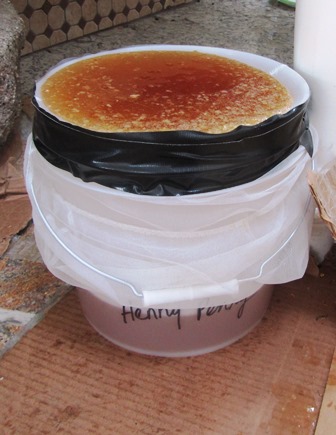
Pictured is a Henny Penny Farmette honey bucket with strainer taped on and bits of wax in the honey on top
His wife helped me scrape off the bee glue from each frame and then open the capped cells (a must) before draining the honey. We then used their machine that can spin twenty frames at a time. It has an electric motor and a control to increase or decrease the speed. Use slow speed to begin and then when the frames grow lighter, you increase the speed.
In all, I spun four hive boxes full (ten frames each), except for one box that had fewer because we left two frames behind in the apiary. They still had babies in them.
We taped fine-mesh filters over the tops of several five-gallon buckets. To spin the honey out of the first eighteen frames took many hours, from noon to about ten o’clock at night. We left the machine spigot open all night to allow the draining to continue into the bucket. The filters caught bits of wax and even the occasional dead bee, ensuring the honey would be perfectly clean and ready to bottle.
I drained honey from the ten frames in each of my hive boxes–two of my hive boxes held the large frames and two held smaller frames. In all, we spun and drained enough honey to fill three five-gallon buckets and about one-fourth of a two and one-half gallon bucket.
Not a bad yield for a fairly young hive and during summer in a drought year when pollen-laden flowers are not be as plentiful. It’s a bee-eautiful sight to see!
Ants in the Freezer . . . Seriously?
Well, this is embarrassing. I found ants, a big pile of them, in the bottom of the freezer side of my double-door fridge. I thought it was a mound of spilled coffee grounds. But that made no sense. Why would ants venture into the freezer in the first place. Crazy as it seems, I have an idea.
A few weeks ago, my beekeeper neighbor told me about a little trick to sterilize frames before putting them into the hives. He said after I have drained a frame of honey, I should hang it outside in a tree near the hives for the bees to clean (they will eat the honey but leave the wax).
Then, I should put the frame of wax in a freezer so that any tiny pest like the larva of a wax moth or mites or ants will be killed.
After 24 hours, I can remove the frame from the freezer and store it until I’m ready to put it into a hive box. When I harvest honey, I can easily replace a honey-filled frame with an empty frame that has been sterilized in the freezer and already has beeswax. It’s less work for the honeybees to use that frame for brood or honey. Sounds good, right?
Well . . . I wrapped two frames with aluminum foil before putting them in the freezer. But I got lazy and just inserted one frame into the freezer without first wrapping it. It seemed very clean–just white wax left by the bees after they had devoured all the honey.
The unwrapped frame I put in my kitchen freezer must have leaked a drop or two of honey that I didn’t see. It drew those ants. Serves me right.
Now I have a designated freezer to be used only for honeybee frame sterilization. It will stand outside on my patio. I’m pretty sure the ants won’t be visiting my kitchen again. At least, that’s what I’m hoping.
Consumer Concerns Effect Change at Lowe’s and Home Depot
Increasingly, a growing body of science points to the role of bee-toxic pesticides (specifically neonicotinoids) in the global decline of the honeybee populations.
Lowe’s Home Improvement stores announced it will begin to phase out neonicotinoid pesticides (neonics are a class of pesticides harmful to bee health) as soon as suitable alternatives become available. The retailer will also provide customers with more educational materials focusing on pollinator health.
Home Depot has pledged to begin labeling plants on which neonicotinoids have been used. Other retailers are responding to consumer concerns as well.
East coast-based BJ’s Wholesale Club intends to require vendors to label plants free of neonicotinoids; otherwise vendors must label plants on which neonics have been used with a “caution around pollenators” tag.
Ten other retailers in states from California, Colorado, Minnesota, and Maryland have plans to limit or eliminate neonics.
A study published in the Journal Environmental Science and Pollination Research revealed that there is clear evidence that the use of neonicotinoid pesticides are a key factor in honeybee decline.
A False Swarm . . . Sort Of
When I heard my neighbors banging on a pan with a wooden spoon, I sprang into action. It is what we do when a honeybee hive swarms.
As it turned out, my bees had swooped from the hive with their queen into the front yard, past the plum tree and were circling above the blood orange. My neighbors, who were in their courtyard, saw it and began the banging to confuse the bees so they would alight close to their home.
I ran out and, with direction from my beekeeper neighbor, placed the hive near the orange tree. I’d already placed eight frames with wax and my neighbor brought over two with honey on the comb. All seemed to go as planned. We shook the tree and the bees dropped into the prepared hive.
My neighbor went home, and I went back to my computer and the novel I’m writing. Thirty minutes later, the bees were swarming again. I ran out and banged on the pan. They settled down. All seemed well, except for ants that had been in the orange tree and now were in the hive box.
Around nine o’clock at night, I sprayed the outside of the hive with Windex and wiped it with paper towels. I repeated the procedure around the perimeter of the box, replaced the lid, and carried the hive box back to the apiary believing all would be well. It wasn’t.
This morning, I ran out and suited up in my beekeeper’s outfit and gloves, opened the new hive box, and looked in. To my dismay, all the bees were gone.
My neighbor later told me over coffee that the bees had likely returned to their old hive as small swarms sometimes do. So . . . I suppose I may be repeating this whole scenario at some point in the days ahead. My neighbor reminded me that the weather has been strange, and the weather affects the bees’ behavior.
Northern California Nut Trees in a Nutshell
Take a trip into Northern California’s great Central Valley and you’ll notice how the landscape becomes dotted with nut tree farms along with vegetable fields, fruit tree orchards, and dairy farms. While Texas dominates the pecan tree market, California’s big three nut crops are almonds, walnuts, and pistachios. With nut prices on the increase, backyard gardeners might consider planting a tree or two if they have the space.
Some nut trees, such as almonds, require pollination assistance–a couple of different cultivars and honeybees will do the trick. For this reason, commercial almond growers pay beekeepers to bring their hives in to pollinate California’s early almond crop each year. Growing almonds is big business in California (it’s the third leading agricultural product in the state); the decline in honeybee populations is bound to affect this profitable crop.
The Central Valley has the perfect climate and growing conditions for almonds. It’s estimated that there are roughly 5,500 almond growers in the state. Many are commercial growers who capitalize on the rich, well-drained soil, and the hot summers and cool winters of Northern California. But California’s continuing drought is causing concern to almond growers since almonds require a lot of water. Backyard gardeners, too, must consider the water requirement of almonds before planting trees.
A newly formed almond on the tree looks like an unripe fuzzy peach because almonds are related to the peaches. Mature almond trees reach 20 to 30 feet tall. Some popular cultivars in zones 5 through 8 are Hall’s Hardy, Nonpareil, Peerless, and Mission. My neighbors have gorgeous, healthy almonds growing on their farmette.
The California Black Walnut and Persian Walnut (with cultivars of Franquette, Chandler, and Hartley) are valued for their stateliness, shade, bountiful crops, and longevity. Walnuts contain healthy nutrients. Cultivars of the English walnut are fast-growing and the nuts are thin-skinned and bountiful.
If a walnut is planted at the birth of an individual, and he lives 75 years, that walnut tree might could still be growing when the person breathes his last breath. The black walnut can reach 100 feet in height. The nuts have an thick outer hull that can blacken sidewalks and driveways with their stain; also, the tree also can be toxic to other plants.
In comparison to walnuts, filberts/hazelnuts are considered small trees (achieving heights of only 10 to 40 feet), they are often the nut tree of choice for backyard landscapes. DuChilly and Daviana are excellent pollinizers with Barcelona. Other cultivars are Bixby, Royal, and Hall’s Giant.
Pecan trees grow much larger than filberts, often towering 70 to 150 feet. Some cultivars include Major, Peruque, Stuart, and Colby. The cultivars of Wichita, Western Schley, and Cherokee are excellent pollinators for each other. Of all the nuts valued for their antioxidants, pecans rank the highest.
There is a pistachio tree growing a mile or so from my farmette. While pistachios love the Mediterranean climate of the Central Valley, in some places the trees perform better than in others. The nuts are highly valued by consumers. Growers have taken notice. Pioneer Gold, a varietal that’s been around since 1976, remains a popular choice. The trees are wind pollinated and require a male and female tree for a crop set.
If you have room in a backyard garden or on a farmette or field, consider planting one or more nut trees. You’ll be rewarded with shade and heart-healthy, nutritional snacks for years to come.
Scientific Studies Show Negative Effects of NeoNics
Neonicotinoids, commonly referred to as neonics, are a new class of pesticides that are closely related to nicotine. As the U.S. government debates the use of these controversial chemicals and studies go on, the European Union has voted to ban bee-harming pesticides. See, http://www.theguardian.com/environment/2013/apr/29/bee-harming-pesticides-banned-europe.
There’s no question that the bee population has been in decline in the last decade. Many beekeepers and experts alike have been vocal in their suspicions that exposure to neonicotinoid pesticides is a likely culprit. The journal Nature published a study that revealed significant negative effects on the wild bumble bee foraging on plants sprayed with the new class of pesticides.
Pollinators of all types are important to our food crops, but especially the bumble bees and honeybees. The latter are trucked around to farms and orchards (particularly the almond orchards) in early spring to pollinate the blossoms.
Exposure to neonicotinoid pesticides resulted in wild bees doing less reproducing, having smaller colonies, and having colonies that didn’t grow as compared to wild bees not exposed to the neonics.
One of the studies was the result of research done in the wild, using 16 patches of land divided into two parcels of eight patches each. One area used canola seeds coated with the pesticide containing neonics. The seeds were not coated in the other area.
Scientists then compared the bees exposed to the pesticide with bees not exposed. The treated side had half as many bees per square meter as the untreated side. The bees in the pesticide patches also had negligible weight gain, but the bees in the untreated area gained roughly one pound.
Neonicotinoids are now the world’s most widely used pesticides. Isn’t it time farmers of the world found other options and chemical companies put less money into lobbying for these bee-dangerous chemicals and instead searched for good alternatives to help farmers deal with pests in their fields and orchards?
Flowers, Nest-Building, and Bee Swarms . . . Spring Has Arrived
The wisteria hangs in long purple bracts, its color finding resonance in the grape hyacinth blooms and the lavender buds. Delicate blossoms of pink and white create canopies of color for the fruit trees, and birdsong fills the air. Spring brings its gifts.
As the blue jay creates a screeching racket to the mockingbird’s ready song, the white-crowned sparrows have taken up residence in a row of birdhouses we’ve placed high on the back fence.The entrances of the sparrow houses are too small for the jay to access; a good thing since jays have earned a reputation as nest robbers.
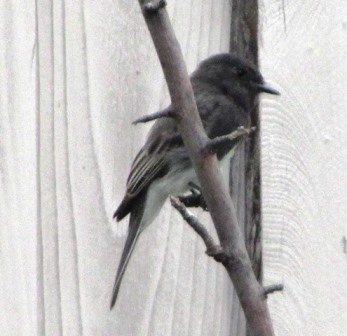
Crew Cut, our resident black phoebe, nests under an eve of the old chicken house; the male teaches its young to catch insects on the wing
Yesterday, I spotted the black phoebe pulling a piece of coir from a wall planter for its nest. These peaceful birds make a sound of tsip or fi-bee, fi-bee and can rise to roughly 50 feet to sing to a female.They range from California to central Texas, and even venture all the way to Argentina.
In the tallest eucalyptus on the acre that stands vacant behind our property, a pair of hawks are also nest-building. My farmette lies in their flight path. Not a good thing to see–hawks swooping down over my chickens and then rising to their lofty nest.
I threw some wildflower seed in beds over the weekend and then, after spotting my neighbor’s errant hen who flew to our yard, I began to regret my action. What can I do now but hope that she’ll not devour the seeds with her constant hunting and pecking?
Last night, I could have sworn I heard the pitter-patter of raindrops against the stone patio floor. With a steaming mug of coffee in hand at four o’clock this morning, I ventured outside and sure enough . . . it was still sprinkling. Hooray! It’s our first spring shower!
So, with all the nest-building and Mother Nature dropping a shower upon us, I know the wildflowers are blooming, too. That means the honeybee season is upon us. My neighbor has already had a bee swarm. I’m not ready, but I can’t stop Mother Nature from beginning a new cycle of seasons just because I don’t yet have my new honey frames assembled. That’s not how it works. Ready or not, spring has arrived.
Giant Sunflowers Provide Food and Fun for Everyone
Giant sunflowers need space to grow to full size; they can reach six or more feet tall. Bees love them for their pollen. Kids love them when the foliage of the plants create a secret fort or a fairy circle. Humans, birds, and squirrels love them for their seeds.
For best results, plant giant sunflowers at the back of a garden. They need good soil and full sun. Plant when the danger of frost has past. A rule of thumb to follow is to plant them about one inch deep and six inches apart. While the seeds are germinating, keep the soil moist.
Later on, when the plants stand about three inches tall, you can begin to thin them. Leave about one foot between each plant. This can enable a strong root system for form. The stalks will become sturdy and measure about three to four inches in circumference when fully grown.
First come the gorgeous petals in green to yellow and then bright yellow. As the bees pollinate the florets and they drop, the seeds will mature. Seeds are either gray or brown in color.
I always cut the heads when the seeds are plump, firm, and begin to drop. I let the heads dry well in the sun for days before I remove the seeds. Fully dry seeds can be stored in containers for human consumption or to be fed to the squirrels and birds.
* * *
If you enjoy reading about farmette topics (including gardening, beekeeping, and delicious recipes), check out my cozy mysteries A BEELINE TO MURDER and also THE MURDER OF A QUEEN BEE in the Henny Penny Farmette series (from Kensington Publishing).
These novels are available through online retailers such as Amazon, Barnes & Noble, Kobo Books, and Walmart as well as from traditional bookstores everywhere.
See, http://tinyurl.com/hxy3s8q
Now available in mass market paperback, this debut novel launched the Henny Penny Farmette series of mysteries and sold out its first press run.
See, http://tinyurl.com/h4kou4g
The second cozy mystery in the Henny Penny Farmette series, available Sept. 27, 2016
 Facebook
Facebook Goodreads
Goodreads LinkedIn
LinkedIn Meera Lester
Meera Lester Twitter
Twitter




